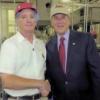We are a bakery here in the US. We have recorded lot codes of all ingredients on our bakers sheets for the past several years per traceability requirements. Our procedure is to have the bakers do this as they mix. The bakers manually write these down as they mix. Often they get behind in the recording of the numbers as they struggle to stay up with the depositing line. This is also a struggle for the bakers who are in training as they struggle with learning the skills of being a mixer, coupled with the speed of the line and the need to write down all the codes. Sometimes a person who is totally capable of being a good mixer, is let go because they struggle with keeping up with lot recording. Some of our formulas can have up to 20 ingredients and the lot codes are cumbersome to record.
Perhaps someone out there has encountered this issue and tackled it a different manner than we are. I know there are software programs and production station recording devices that can be used but we really aren't in a position to do that. Looking for some ideas that may have worked for my forum colleagues.
Thanks,
Bill
- Home
- Sponsors
- Forums
- Members ˅
- Resources ˅
- Files
- FAQ ˅
- Jobs
-
Webinars ˅
- Upcoming Food Safety Fridays
- Recorded Food Safety Fridays
- Upcoming Hot Topics from Sponsors
- Recorded Hot Topics from Sponsors
- Food Safety Live 2013
- Food Safety Live 2014
- Food Safety Live 2015
- Food Safety Live 2016
- Food Safety Live 2017
- Food Safety Live 2018
- Food Safety Live 2019
- Food Safety Live 2020
- Food Safety Live 2021
- Training ˅
- Links
- Store ˅
- More



















